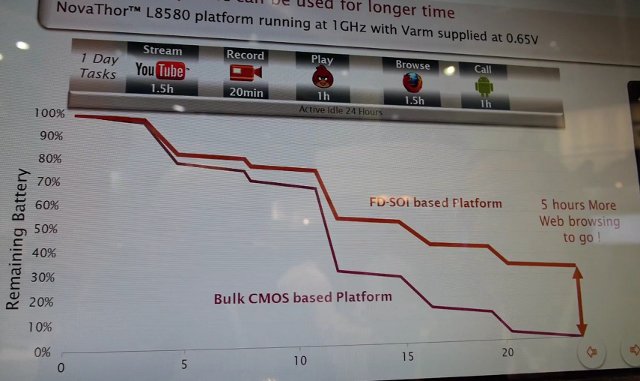ST Ericsson already showcased NovaThor L8580 Cortex A9 processor @ 2.8 GHz at CES 2013. The processor features a technology called eQuad, and as I previously noticed there’s no mention of the number of cores at all on the website and many websites reported the processor featured 4 cores. The processor actually features 2 Cortex A9 core, but thanks to FD-SOI technology they are able to do the equivalent of a Quad Core big.LITTLE processor (i.e. 2x Cortex A15 + 2x Cortex A7) electrically.

Since this is just done electrically, you can use the same software as before and will consume much less power, whereas big.LITTLE requires a lot of kernel work. A Cortex A9 will obviously be less powerful than a Cortex A15, but since they are able to boost the frequency up to 3GHz (probably limited to 2.5Ghz in actual product) this can compensate the lower performance, and the die size will be much smaller than on a quad core big.LITTLE processor, since you only need 2 cores for similar power consumption and performance. Charbax uploaded a video with a nice explanation of the system at MWC2013. The first part of the video is very interesting as it explains the technology and its advantage. One particularly interesting part is when Charbax asked about big.LITTLE, and ST Ericsson representative explains that big.LITTLE processing is not so interesting now that FD-SOI is available, and it will also end up in cortex A15 processor. He did not say FD-SOI eQuad was a big.LITTLE killer, but it was close :). He may be right about IKS big.LITTLE implementation, but with HMP big.LITTLE, where they can use all cores, big.LITTLE will certainly retain its advantage. What do you think?
If you want more information about the other features of this processor, refer to my earlier post “ST Ericsson Demonstrates NovaThor L8580 Multi Cortex A9 SoC @ 2.8 GHz”
Via armdevices.net
Update: If you want to know more about eQuad, you can read FD-SOI eQuad White-Paper (15-page PDF), that explains the technology, and also explains that heterogeneous multiprocessing (HMP) is a promising technology, but it’s highly complex both in terms of hardware and software, and it may take a few years to reach its full potential.

Jean-Luc started CNX Software in 2010 as a part-time endeavor, before quitting his job as a software engineering manager, and starting to write daily news, and reviews full time later in 2011.
Support CNX Software! Donate via cryptocurrencies, become a Patron on Patreon, or purchase goods on Amazon or Aliexpress




